Dog-friendly Yards and Landscapes
Emily Fielder2024-01-04T09:21:57-06:00GUEST AUTHOR – Len Nadalo, Dallas County Master Gardener
The backyard of your home should be a place that is safe and inviting for you and your dog to share enjoyment and companionship. A dog-friendly yard is a must! While you may want your dog to get exercise, your dog should learn that a yard is also a place to throw balls, catch frisbees, and enjoy the sounds and sights of nature. With some planning, your dog will eagerly look forward to the time you spend together. The primary requirements of a dog-friendly yard and landscape are safety, layout planning, and humane considerations.
Dog-Friendly Yard Consideration: Define the Area
Safety, security, and comfort must be ready on the first day “home” for a newly-adopted dog to develop a bond between the dog and its new family. Be sure that your dog is fully vaccinated and is maintained on a medication to prevent heartworm and other mosquito-borne diseases.
During the Covid-19 epidemic, many people adopted dogs in hopes of enrichment and joy to the pets and pet owners. Planning and preparing for a new dog should begin with assessing your yard, landscape, and other physical elements that you share with a pet.
Dog-Friendly Fencing
A proper fence will discourage (prevent) your dog from jumping or climbing over the top. The height and style of the fence will be determined by the size and breed of your dog. First, the top should be straight and smooth. The lower half should have narrow slats (so-called “puppy panels”) to prevent entrapment of the dog’s head or injury to its neck. Additionally, the fence should go to the ground to discourage digging. Special provisions may be necessary for large dogs, such as “electronic” collars and fencing.
Dog-Friendly Accessories
When defining the area, you should give special consideration to protecting your pup’s running pads on its paws. For example, consider using distressed granite for steps, walkways, and paths. Also, birdbaths and yard art should be substantial, secure, made of stone or bronze, and unpainted or painted with a non-toxic finish.
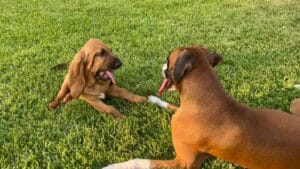
Dog-Friendly Yard Consideration: Physical Comfort
When creating a dog-friendly yard, it’s important to keep physical comfort in mind. Especially heading into the summer months, provide shade and a comfortable location if you plan to leave your dog outside for even a few hours. And never leave a dog or any pet out in the yard when temperatures are very hot or cold or when a storm is near. Always have fresh water available to any dog left for more than a few hours.
Dog-Friendly Yard Consideration: Electrical Safety
Electrical safety is critical when you plan to keep puppies in your yard. Use only low-voltage lighting in landscapes that are accessible to a dog. Never leave unattended electrical cords plugged into an outside socket.
All electrical outlets should have safety covers.
Dog-Friendly Yard Consideration: Exposure to Toxic Chemicals
Read, understand, and follow the manufacturers’ instructions, guidelines, and warnings of the chemicals you use in your yard. Pesticides and poisons used to treat the lawn, control slugs, snails, or kill fire ants are a significant risk to your dog.
If you believe your dog has come in contact with or has consumed a poison contact:
- Pet Poison Helpline: 855-764-7661
- ASPCA Animal Poison Control Center: 888-426-4435
Dog-Friendly Yard Consideration: Garden Safety
When it comes to creating a dog-friendly yard, gardening should be near the top. While looking for beautiful flowers or low maintenance plants, you also should consider the toxicity and physical make-up of various plants in your yard and where and how to store your garden tools.
Do not plant plants with long thorns or spines where your dog might want to run. Additionally, many plants are toxic to dogs; therefore, be concerned if one of the plant beds that contains a toxic plant is disturbed.
It’s important to note that plants grown in hanging baskets are particularly tempting to dogs. Investigate the potential risk to your dog or young children whenever you decide to introduce a new plant, shrub, vine, or tree into your landscape, mainly if the plants are located where your dog can be in direct contact.
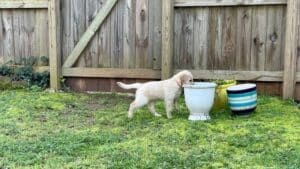
Common plants that are moderately or highly toxic to dogs:
Aloe Vera
Aloe Vera can harm a dog’s digestive system if ingested.
Azaleas
Avoid azaleas entirely when considering what to put in your dog-friendly yards. They can be fatal if your dog even chews on leaves. Be aware of initial gastrointestinal signs, which, when untreated, can lead to coma and even death.

Cyclamen
For digging dogs, cyclamen’s root causes problems.
Daffodils
Daffodil flowers, leaves, and bulbs can cause abdominal pain, vomiting, and diarrhea.
Elephant Ear
These plants are so large and easy for pets to get into, making it even more vital to keep them out of your home. If your pup consumes Elephant Ear, your dog may develop symptoms such as vomiting, increased drooling, difficulty swallowing, or burning/swelling of the mouth. This plant has been known to cause breathing problems and, in some cases, death.
Hyacinths
The bulbs are toxic. Mild cases show drooling and some vomiting. If dogs eat too many, they may show an increase in heart rate.

Ivy
The leaves, roots, and stems are toxic when eaten. Prolonged contact with Ivy may cause issues ranging from a minor rash to breathing problems. In extreme cases, coma or paralysis can happen when a dog ingests Ivy.
Jade
The Jade plant (Japanese Rubber Plant, or the Jade Tree) is most commonly maintained as a house plant. However, some gardeners use the spring and fall to locate house plants temporarily in shaded locations in the landscape. Jade is very toxic to canines, and it can cause slow heart rate, depression, vomiting, and decreased coordination.
Lily of the Valley
Dogs who eat lily of the valley plants may experience cardiac arrhythmias, decreased heart rates, and seizures.
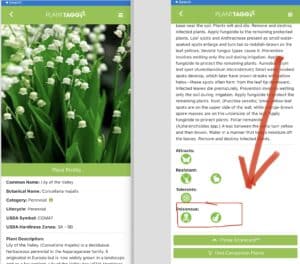
Oleander
If your dog chews on oleander leaves, flowers, or branches, it may suffer from a decreased heart rate, which can be fatal.
If you suspect your dog has eaten a poisonous plant, contact an Emergency Hotline:
- Pet Poison Helpline: 855-764-7661
- ASPCA Animal Poison Control Center: 888-426-4435
- The National Institute for Occupational Safety and Health (NIOSH)
You can explore a full list of toxic plants to avoid in your dog-friendly yard on the CDC website here: https://www.cdc.gov/niosh/topics/plants/default.html
With moderate effort and planning, you and your dog can share the joys of the outdoor environment while still enjoying our gardens and landscape.
And, if you’re curious if your existing plants are dog friendly, check them out in the PlantTAGG app! Each plant profile includes a notation on whether or not the plant is toxic or poisonous to our pups. Let’s keep them safe so we can enjoy this beautiful weather with them for years to come!
Text “PLANTS” to 46376 to get started. It’s free to use and offers the most comprehensive plant information and plant care guidance at your fingertips!


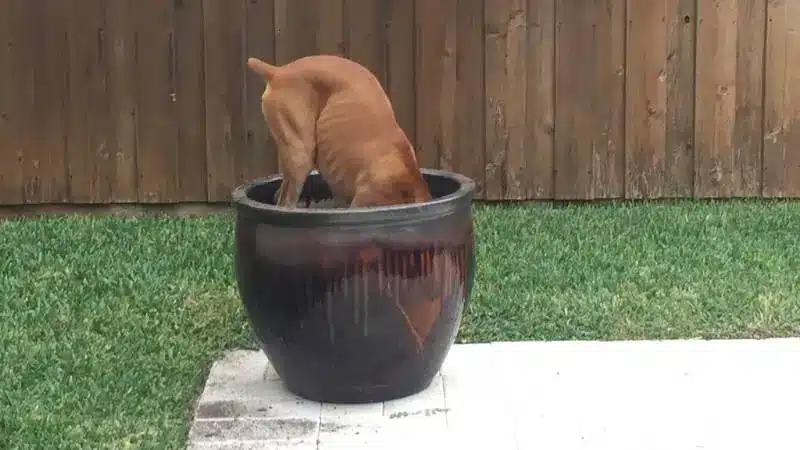

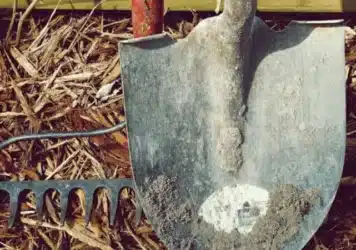
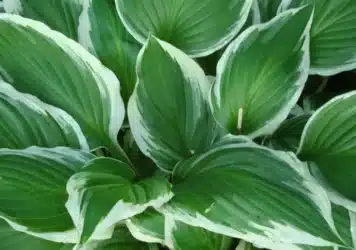

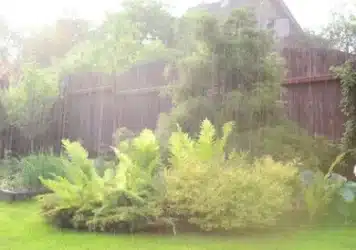
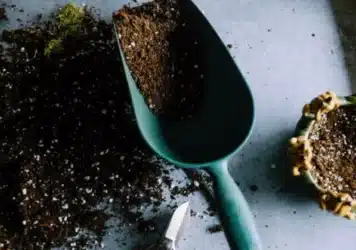
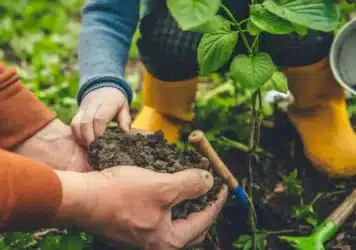
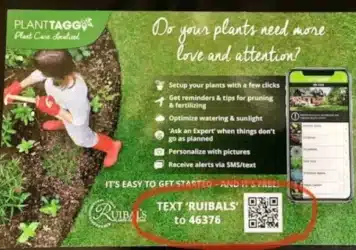


Comments (2)
Very timely article as we are in the process of updating our backyard and want any new plants to be dog friendly which can be a challenge between taking into account the other factors of sun, soil, and zone. PlantTagg’s Thrive scorecard and the poisonous to pets warning has helped me tremendously in making the right plant choices for our backyard.
Knowing my dog (Barry) I can’t have anything in the yard besides grass. The guy will literally eat everything that looks like food (flowers included). One time we sent him to my mother house and she has a large garden full of different crops such as garlic onions and cilantro etc., my dog decides to dig up the garlic and EAT IT. A quick trip to the vet and some doggo barf later Barry comes home fine like nothing has happened….moral of the story, dogs will eat anything and I need to make a dog proof fence at Mama’s house.